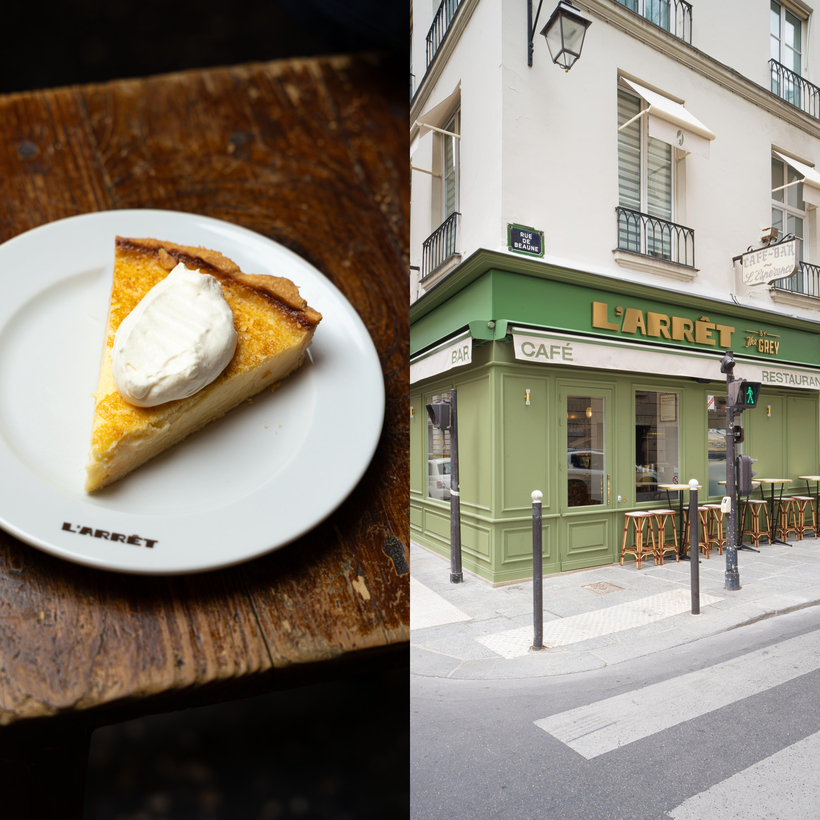“It’s been quite a journey,” observed restaurateur Johno Morisano over the struggle to open L’Arrêt by the Grey, a new restaurant in Paris’s Seventh Arrondissement. “But now, the bus stops here,” he said with a smile. (“Un arrêt” is French for “bus stop.”)
The American restaurateur, who also owns and operates the venerated Savannah restaurant the Grey, alongside chef Mashama Bailey, was referring to the two-year legal battle to install a ventilation system. But the biggest challenge this new restaurant will face is only just beginning.
The French have developed an appetite for stereotypical handheld American foods such as cheeseburgers, hot dogs, tacos, and lobster rolls. But here, Bailey’s menu is inspired by the cooking of Savannah and other Southern ports, including Charleston, Mobile, and New Orleans. Her dishes seek to seduce the most persnickety Parisians with a culinary subtlety and refinement they not only don’t associate with American food but consider to be almost entirely their own.

Fortunately, Bailey has a head start—her cooking has already been admired by the French. In the spring, she was selected by the champagne house Veuve Clicquot to cook at the banquet that launched its La Grande Dame 2018 vintage, at the Jardins des Plantes, in Paris. Bailey’s corn bread and “pot liquor”—vegetable broth with crabmeat, turnips, and turmeric sabayon—was an elegant expression of Low Country cooking that beautifully flattered the wine.
But in the competitive eco-system of Parisian restaurants, Morisano isn’t taking any chances. He understands that cooking is often a form of storytelling, with the waitstaff serving as interpreters. So he invited Jessica B. Harris, a well-known historian of African-American cooking and the author of High on the Hog, to spend two days educating the staff and contextualizing Bailey’s cooking in this rich tradition.
On a rainy afternoon shortly before the restaurant’s September 16 opening, Harris occupied a corner booth, enjoying a glass of Pinot Noir and a bowl of soup brimming with black-eyed peas. On a shelf behind her was a brass Art Deco statuette of a greyhound, which Morisano found at a flea market. (Their Savannah restaurant occupies the premises of that city’s former Greyhound bus station.)

Her previous day’s lecture had covered the experiences of artists such as Josephine Baker and James Baldwin, and how the French capital had offered them a freedom of expression that could transcend the endemic racism of the United States. “I do note, however, that the French fascination with Afro-Americans does not always extend to Africans from Africa,” she said. “There’s racism in France too.”
“People open restaurants to create a community,” she continued. “They’re places to come together and share a heritage, even one you don’t know.” She referenced restaurants such as Chez Haynes, which was opened by a Black American army veteran and his French wife after World War II.
An hour later, the staff sat down in the dining room for Harris’s second lecture, which she delivered in the fluent French she’d learned while studying in Paris as a college student. Her pupils were from the Congo, the Ivory Coast, Algeria, Morocco, Portugal, and elsewhere, and they were immersed in her discussion of the foods that make up Bailey’s cooking—seafood, rice, greens, pickles, and more, along with seasonings like curry powder, which was introduced by European and New England ships coming to load cargoes of rice, indigo, and cotton. Afterward, she concluded, “Now you are all ambassadors for Afro-American cooking, and for that, I thank you.”

Meanwhile, in the kitchen, Bailey was continuing to refine her menu. “Southern-port cooking and French cooking are sort of like cousins, but they just don’t know it yet,” she said. “I want to explore these connections and go deeper with them.”
Odds are good, too, that the worldly inhabitants of the Seventh Arrondissement will be drawn to Bailey’s roasted oysters, macaroni and cheese, chess pie, and Chicken Country Captain, a classic Charleston dish of chicken braised in a curried-tomato-and-pepper sauce with currants and almonds. “Ultimately, I want this restaurant to become a culinary dialogue,” she said with a big smile. “So the best is probably yet to come.”
Alexander Lobrano is a Writer at Large at AIR MAIL. His latest book is the gastronomic coming-of-age story My Place at the Table: A Recipe for a Delicious Life in Paris


